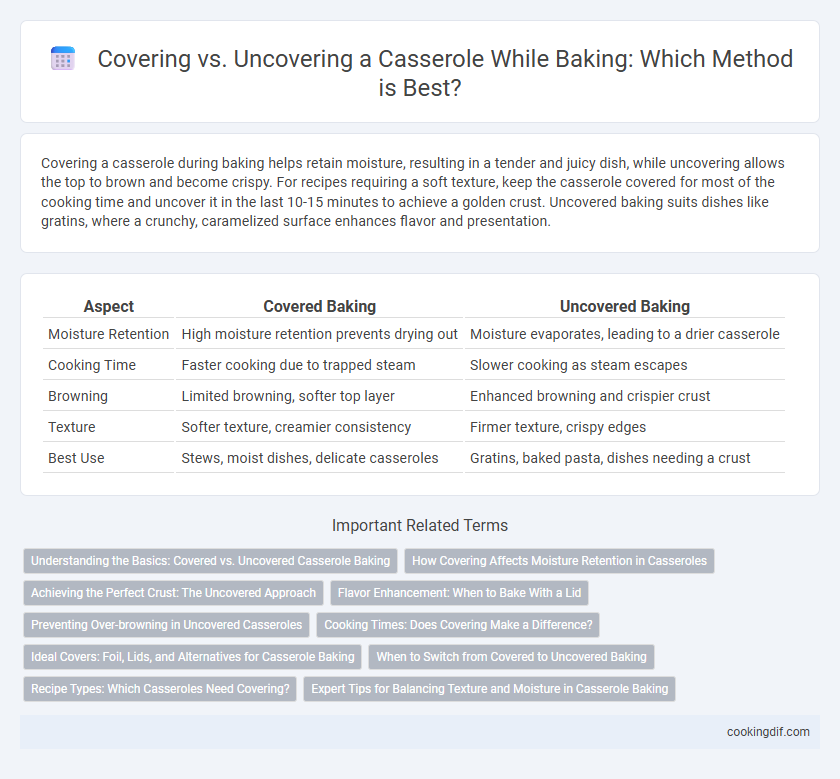Covering a casserole during baking helps retain moisture, resulting in a tender and juicy dish, while uncovering allows the top to brown and become crispy. For recipes requiring a soft texture, keep the casserole covered for most of the cooking time and uncover it in the last 10-15 minutes to achieve a golden crust. Uncovered baking suits dishes like gratins, where a crunchy, caramelized surface enhances flavor and presentation.
Table of Comparison
| Aspect | Covered Baking | Uncovered Baking |
|---|---|---|
| Moisture Retention | High moisture retention prevents drying out | Moisture evaporates, leading to a drier casserole |
| Cooking Time | Faster cooking due to trapped steam | Slower cooking as steam escapes |
| Browning | Limited browning, softer top layer | Enhanced browning and crispier crust |
| Texture | Softer texture, creamier consistency | Firmer texture, crispy edges |
| Best Use | Stews, moist dishes, delicate casseroles | Gratins, baked pasta, dishes needing a crust |
Understanding the Basics: Covered vs. Uncovered Casserole Baking
Covering a casserole during baking traps moisture, resulting in tender, evenly cooked dishes by preventing drying out and preserving flavors. Uncovered casseroles develop a crispy, browned top, ideal for achieving a golden crust and concentrated taste. Selecting between covered or uncovered baking depends on the desired texture and moisture level of the finished casserole.
How Covering Affects Moisture Retention in Casseroles
Covering a casserole during baking traps steam, significantly enhancing moisture retention and resulting in a juicier, more tender dish. The lid or foil prevents evaporation, maintaining optimal internal humidity levels and preventing the casserole from drying out. Uncovered casseroles typically develop a browned, crisp top but risk moisture loss, which can lead to a drier texture inside.
Achieving the Perfect Crust: The Uncovered Approach
Baking casseroles uncovered allows moisture to evaporate, resulting in a golden, crispy crust that enhances flavor and texture. Covering traps steam, which can create a soggy surface and prevent browning. For a perfectly textured casserole with a delectable crust, leaving it uncovered during the final baking stages is essential.
Flavor Enhancement: When to Bake With a Lid
Baking casseroles with a lid traps moisture and steam, preserving the natural flavors and ensuring a tender, juicy texture. Covering during the initial baking phase helps infuse ingredients with deeper, more concentrated flavors by preventing evaporation. Removing the lid in the last 10-15 minutes allows the top to brown and develop a desirable crust without sacrificing moisture retention.
Preventing Over-browning in Uncovered Casseroles
Covering casseroles with foil or lids during baking helps trap moisture, preventing the top layer from over-browning and drying out. Uncovered casseroles are prone to faster browning due to direct heat exposure, which can result in burnt edges and uneven cooking. Using a cover maintains even heat distribution and preserves the desired texture without compromising flavor.
Cooking Times: Does Covering Make a Difference?
Covering a casserole during baking traps moisture, resulting in a shorter cooking time and a more tender texture, while uncovering allows moisture to evaporate, producing a thicker, browned crust but often requiring longer baking. Dishes with sauces or delicate ingredients like vegetables benefit from covering to prevent drying out, whereas casseroles relying on crispy toppings, such as cheese or breadcrumbs, are best baked uncovered. Adjusting cooking times by 10-20% depending on whether the casserole is covered or uncovered ensures optimal texture and doneness.
Ideal Covers: Foil, Lids, and Alternatives for Casserole Baking
Ideal covers for casserole baking include aluminum foil, oven-safe lids, and reusable silicone covers, each ensuring even heat distribution while preventing moisture loss. Foil offers a flexible, inexpensive option that can be tightly sealed to lock in steam, preserving the casserole's tenderness and preventing a dry crust. Oven-safe glass or metal lids provide a sturdy cover for consistent cooking, while silicone alternatives offer eco-friendly reusability and a reliable seal against splatters and drying out.
When to Switch from Covered to Uncovered Baking
Start baking casseroles covered to retain moisture, especially during the initial 30-45 minutes, preventing the dish from drying out. Switch to uncovered baking in the last 15-20 minutes to allow the top to brown and become crispy, enhancing texture and flavor. This method works well for casseroles containing cheese, breadcrumbs, or other toppings that benefit from direct heat exposure.
Recipe Types: Which Casseroles Need Covering?
Casseroles with ingredients that require longer cooking times or moisture retention, such as rice, pasta, or dense vegetables, benefit from being covered during baking to prevent drying out. Recipes featuring delicate toppings like cheese or breadcrumbs may need to be uncovered toward the end to achieve a browned, crispy crust. Souffle-style or lighter casseroles typically require covering at first and uncovering later to balance thorough cooking with desired texture.
Expert Tips for Balancing Texture and Moisture in Casserole Baking
Covering a casserole with foil or a lid during baking traps steam, preserving moisture and results in a tender, juicy texture. Uncovering the dish in the final 10-15 minutes allows the top to brown and crisp, enhancing flavor and visual appeal. Experts recommend starting covered to maintain moisture and finishing uncovered to achieve the ideal balance between creamy interiors and a golden, crispy crust.
Covering vs uncovering during baking Infographic

 cookingdif.com
cookingdif.com